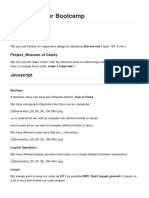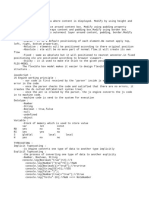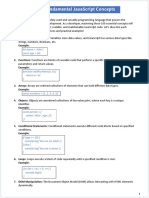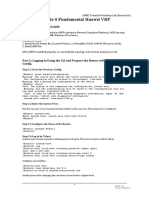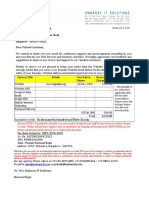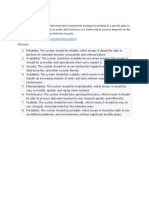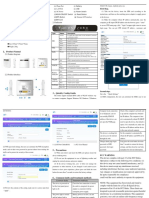JavaScript Fundamentals: A Beginner's Guide (1-2
Weeks)
Welcome to the wonderful world of JavaScript! Think of JavaScript as the magic that makes
websites come alive - like adding colors to a coloring book or making toys move and dance.
Table of Contents
1. Getting Started
2. Variables - Your Data Containers
3. Functions - Your Helper Friends
4. Arrays - Your Toy Boxes
5. Objects - Your Treasure Chests
6. Async/Await - Waiting Patiently
7. Modules - Sharing Your Toys
8. Node.js Basics - JavaScript Outside the Browser
9. Resources for Further Learning
Getting Started
What You Need
Before we start our JavaScript adventure, let's gather our tools:
1. A Computer - Like having a playground to build in
2. A Text Editor - We recommend Visual Studio Code (it's free!)
3. A Web Browser - Chrome, Firefox, or Safari work great
4. Node.js - We'll install this later for the Node.js section
Setting Up Your First JavaScript File
Step 1: Create a folder
mkdir my-javascript-learning
cd my-javascript-learning
Step 2: Create your first HTML file
Create a file called index.html:
<!DOCTYPE html>
<html>
<head>
<title>My JavaScript Learning</title>
</head>
<body>
<h1>Hello, JavaScript World!</h1>
<script src="script.js"></script>
</body>
</html>
Step 3: Create your JavaScript file
Create a file called script.js:
console.log("Hello, World!");
Step 4: Open in browser
Double-click your index.html file to open it in your browser, then press F12 to see the console
where your message will appear!
Variables - Your Data Containers
Think of variables like different types of containers in your room:
Types of Containers (Variable Declarations)
// let - like a toy box you can change what's inside
let myToyBox = "teddy bear";
myToyBox = "robot"; // You can change it!
// const - like a treasure chest that stays locked
const myTreasure = "golden coin";
// myTreasure = "silver coin"; // This won't work!
// var - like an old container (we don't use this much anymore)
var oldContainer = "old stuff";
Different Types of Things to Store
// Numbers - like counting your toys
let numberOfToys = 5;
let price = 12.99;
// Text (Strings) - like name tags
let myName = "Alex";
let favoriteColor = "blue";
// True or False (Booleans) - like yes/no questions
let isHappy = true;
let isRaining = false;
// Nothing (null and undefined)
let emptyBox = null;
let forgottenToy; // This is undefined
Fun Example: Pet Store
let petName = "Fluffy";
let petAge = 3;
let isPetHungry = true;
console.log("My pet " + petName + " is " + petAge + " years old");
console.log(`My pet ${petName} is ${petAge} years old`); // This is called template liter
Functions - Your Helper Friends
Functions are like having helpful friends who can do specific jobs for you!
Creating Your Helper Friend
// Basic function - like teaching a friend a new trick
function sayHello() {
console.log("Hello there!");
}
// Call your friend to do the trick
sayHello(); // Prints: Hello there!
Functions That Take Instructions
// Function with parameters - like giving your friend specific instructions
function greetPerson(name) {
console.log("Hello, " + name + "!");
}
greetPerson("Sarah"); // Prints: Hello, Sarah!
greetPerson("Tom"); // Prints: Hello, Tom!
Functions That Give You Something Back
// Function that returns something - like asking a friend to bring you something
function addTwoNumbers(first, second) {
return first + second;
}
let result = addTwoNumbers(5, 3);
console.log(result); // Prints: 8
Modern Way: Arrow Functions
// Arrow functions - a shorter way to write functions
const multiply = (a, b) => {
return a * b;
};
// Even shorter for simple functions
const square = (x) => x * x;
console.log(square(4)); // Prints: 16
Real Example: Pizza Calculator
function calculatePizzaSlices(numberOfPeople, slicesPerPerson = 2) {
return numberOfPeople * slicesPerPerson;
}
let partySize = 6;
let totalSlices = calculatePizzaSlices(partySize);
console.log(`We need ${totalSlices} pizza slices for the party!`);
Arrays - Your Toy Boxes
Arrays are like toy boxes where you can store multiple things in order!
Creating Your Toy Box
// Empty toy box
let emptyBox = [];
// Toy box with toys
let myToys = ["teddy bear", "robot", "ball", "puzzle"];
// Mixed toy box (you can store different types)
let mixedBox = ["toy car", 5, true, "doll"];
Playing with Your Toys
let fruits = ["apple", "banana", "orange"];
// Looking at specific toys (counting starts from 0!)
console.log(fruits[0]); // Prints: apple
console.log(fruits[1]); // Prints: banana
// Adding new toys
fruits.push("grape"); // Adds to the end
fruits.unshift("strawberry"); // Adds to the beginning
console.log(fruits); // ["strawberry", "apple", "banana", "orange", "grape"]
// How many toys do you have?
console.log(fruits.length); // Prints: 5
// Remove toys
fruits.pop(); // Removes last toy
fruits.shift(); // Removes first toy
Fun Array Methods - Like Special Tricks
let numbers = [1, 2, 3, 4, 5];
// Map - transform each item (like painting all toys red)
let doubledNumbers = numbers.map(num => num * 2);
console.log(doubledNumbers); // [2, 4, 6, 8, 10]
// Filter - pick only certain items (like choosing only red toys)
let bigNumbers = numbers.filter(num => num > 3);
console.log(bigNumbers); // [4, 5]
// Find - look for one specific item
let foundNumber = numbers.find(num => num === 3);
console.log(foundNumber); // 3
// For each - do something with each toy
numbers.forEach(num => {
console.log("Number: " + num);
});
Real Example: Shopping List
let shoppingList = ["milk", "bread", "eggs"];
// Add items
shoppingList.push("butter", "cheese");
// Check if we need something
if (shoppingList.includes("milk")) {
console.log("Don't forget the milk!");
}
// Show the list
console.log("Shopping List:");
shoppingList.forEach((item, index) => {
console.log(`${index + 1}. ${item}`);
});
Objects - Your Treasure Chests
Objects are like special treasure chests where each treasure has a name tag!
Creating Your Treasure Chest
// Empty treasure chest
let emptyChest = {};
// Treasure chest with treasures
let myPet = {
name: "Buddy",
type: "dog",
age: 3,
isHappy: true
};
Looking at Your Treasures
let car = {
brand: "Toyota",
model: "Camry",
year: 2023,
color: "blue"
};
// Two ways to look at treasures
console.log(car.brand); // Prints: Toyota
console.log(car["model"]); // Prints: Camry
// Adding new treasures
car.owner = "John";
car["price"] = 25000;
console.log(car);
Objects with Functions (Methods)
let robot = {
name: "R2D2",
battery: 100,
// Functions inside objects are called methods
speak: function() {
console.log("Beep beep!");
},
// Modern way to write methods
walk() {
console.log(this.name + " is walking");
this.battery -= 10;
},
checkBattery: () => {
console.log("Battery: " + robot.battery + "%");
}
};
robot.speak(); // Prints: Beep beep!
robot.walk(); // Prints: R2D2 is walking
robot.checkBattery(); // Prints: Battery: 90%
Real Example: Student Report Card
let student = {
name: "Emma",
grade: 5,
subjects: {
math: 95,
science: 88,
english: 92
},
getAverageGrade() {
let scores = Object.values(this.subjects);
let total = scores.reduce((sum, score) => sum + score, 0);
return total / scores.length;
},
addSubject(subject, score) {
this.subjects[subject] = score;
}
};
console.log(`${student.name}'s average: ${student.getAverageGrade()}`);
student.addSubject("art", 98);
console.log(student.subjects);
Async/Await - Waiting Patiently
Sometimes we need to wait for things, like waiting for a pizza to be delivered!
Understanding Promises
// A promise is like ordering pizza - it will either arrive or something goes wrong
let pizzaOrder = new Promise((resolve, reject) => {
let pizzaReady = true; // Let's pretend pizza is ready
setTimeout(() => {
if (pizzaReady) {
resolve("🍕 Pizza is here!");
} else {
reject("😞 Pizza got burnt!");
}
}, 2000); // Wait 2 seconds
});
// Old way - using .then()
pizzaOrder
.then(message => console.log(message))
.catch(error => console.log(error));
The New Way: Async/Await
// Async function - a function that can wait for things
async function orderPizza() {
try {
console.log("Ordering pizza...");
let result = await pizzaOrder; // Wait here until pizza arrives
console.log(result);
console.log("Time to eat!");
} catch (error) {
console.log("Something went wrong: " + error);
}
}
orderPizza();
Real Example: Getting Data from Internet
// Pretend we're getting weather information
async function getWeather(city) {
try {
console.log(`Getting weather for ${city}...`);
// This simulates getting data from internet
let weatherData = await fetch(`https://api.weather.com/${city}`);
let weather = await weatherData.json();
console.log(`Weather in ${city}: ${weather.temperature}°F`);
return weather;
} catch (error) {
console.log("Couldn't get weather data: " + error);
}
}
// Using the function
getWeather("New York");
Simple Delay Function
// Helper function to wait
function wait(seconds) {
return new Promise(resolve => setTimeout(resolve, seconds * 1000));
}
async function countDown() {
console.log("Starting countdown...");
for (let i = 3; i > 0; i--) {
console.log(i);
await wait(1); // Wait 1 second
}
console.log("Blast off! 🚀");
}
countDown();
Modules - Sharing Your Toys
Modules are like sharing your toys with friends - you can give them some toys and use theirs
too!
Creating a Module (ES6 Modules)
mathHelpers.js - Your math toy box
// Functions you want to share
export function add(a, b) {
return a + b;
}
export function multiply(a, b) {
return a * b;
}
export const PI = 3.14159;
// Default export - the main toy you're sharing
export default function subtract(a, b) {
return a - b;
}
Using Modules
main.js - Using your friend's toys
// Import specific functions
import { add, multiply, PI } from './mathHelpers.js';
// Import the default export
import subtract from './mathHelpers.js';
// Import everything
import * as math from './mathHelpers.js';
// Using the imported functions
console.log(add(5, 3)); // 8
console.log(multiply(4, 2)); // 8
console.log(PI); // 3.14159
console.log(subtract(10, 4)); // 6
// Using the everything import
console.log(math.add(2, 2)); // 4
HTML Setup for Modules
index.html
<!DOCTYPE html>
<html>
<head>
<title>Modules Example</title>
</head>
<body>
<h1>JavaScript Modules</h1>
<script type="module" src="main.js"></script>
</body>
</html>
Node.js Basics - JavaScript Outside the Browser
Node.js lets you use JavaScript outside of web browsers - like playing with your toys anywhere,
not just in your room!
Installing Node.js
Step 1: Download Node.js
1. Go to https://nodejs.org/
2. Download the LTS (Long Term Support) version
3. Install it like any other program
Step 2: Check if it worked
Open terminal/command prompt and type:
node --version
npm --version
Your First Node.js Program
hello.js
console.log("Hello from Node.js!");
// Node.js has special built-in modules
const os = require('os');
const path = require('path');
console.log("Your computer type:", os.type());
console.log("Current folder:", __dirname);
console.log("This file:", __filename);
Run it:
node hello.js
Working with Files
fileExample.js
const fs = require('fs');
// Writing to a file (like writing in a diary)
fs.writeFileSync('diary.txt', 'Today I learned JavaScript!');
console.log('Diary entry saved!');
// Reading from a file (like reading your diary)
const diaryContent = fs.readFileSync('diary.txt', 'utf8');
console.log('Diary says:', diaryContent);
// Async way (better for big files)
fs.writeFile('story.txt', 'Once upon a time...', (error) => {
if (error) {
console.log('Error writing story:', error);
} else {
console.log('Story saved!');
}
});
NPM - Your Toy Store
NPM is like a huge toy store where you can get tools made by other people!
Step 1: Create a package.json file
npm init -y
Step 2: Install a package (like buying a new toy)
npm install chalk
Step 3: Use the package
colorful.js
const chalk = require('chalk');
console.log(chalk.blue('Hello in blue!'));
console.log(chalk.red.bold('Hello in red and bold!'));
console.log(chalk.green.underline('Hello in green with underline!'));
Creating Your Own Module
calculator.js
function add(a, b) {
return a + b;
}
function subtract(a, b) {
return a - b;
}
function multiply(a, b) {
return a * b;
}
// This is how you share functions in Node.js
module.exports = {
add,
subtract,
multiply
};
// Or export individually
// module.exports.add = add;
useCalculator.js
const calculator = require('./calculator');
console.log('5 + 3 =', calculator.add(5, 3));
console.log('10 - 4 =', calculator.subtract(10, 4));
console.log('6 × 7 =', calculator.multiply(6, 7));
Real Project: Simple To-Do List
todo.js
const fs = require('fs');
class TodoList {
constructor() {
this.todos = this.loadTodos();
}
addTodo(task) {
this.todos.push({
id: Date.now(),
task: task,
completed: false
});
this.saveTodos();
console.log(`Added: "${task}"`);
}
completeTodo(id) {
const todo = this.todos.find(t => t.id === id);
if (todo) {
todo.completed = true;
this.saveTodos();
console.log(`Completed: "${todo.task}"`);
}
}
listTodos() {
console.log('\n📝 Your To-Do List:');
this.todos.forEach(todo => {
const status = todo.completed ? '✅' : '⭕';
console.log(`${status} ${todo.task} (ID: ${todo.id})`);
});
}
loadTodos() {
try {
const data = fs.readFileSync('todos.json', 'utf8');
return JSON.parse(data);
} catch {
return [];
}
}
saveTodos() {
fs.writeFileSync('todos.json', JSON.stringify(this.todos, null, 2));
}
}
// Using the todo list
const myTodos = new TodoList();
myTodos.addTodo('Learn JavaScript');
myTodos.addTodo('Build a project');
myTodos.addTodo('Celebrate success');
myTodos.listTodos();
Resources for Further Learning
Official Documentation
JavaScript (MDN): https://developer.mozilla.org/en-US/docs/Web/JavaScript/Guide
Node.js Official Docs: https://nodejs.org/en/docs/
NPM Documentation: https://docs.npmjs.com/
Helpful Websites
JavaScript.info: https://javascript.info/ - Excellent tutorials with interactive examples
FreeCodeCamp: https://www.freecodecamp.org/learn/javascript-algorithms-and-data-struc
tures/ - Free interactive courses
Codecademy JavaScript Course: https://www.codecademy.com/learn/introduction-to-java
script
YouTube Video Tutorials
"JavaScript Tutorial for Beginners" by Programming with Mosh: https://www.youtube.co
m/watch?v=W6NZfCO5SIk - Comprehensive 1-hour crash course
"Node.js Tutorial for Beginners" by Programming with Mosh: https://www.youtube.com/
watch?v=TlB_eWDSMt4 - Great introduction to Node.js
"JavaScript ES6 Tutorial" by The Net Ninja: https://www.youtube.com/playlist?list=PL4cUx
eGkcC9gKfw25slm4CUDUcM_sXdml - Modern JavaScript features explained
Practice Platforms
Codepen.io: https://codepen.io/ - Write and test JavaScript in your browser
JSFiddle: https://jsfiddle.net/ - Another great online playground
Node.js REPL: Type node in your terminal for quick testing
Next Steps After This Guide
1. Build Projects: Create a weather app, calculator, or simple game
2. Learn a Framework: Try React, Vue, or Express.js
3. Practice Algorithm Problems: Use LeetCode or HackerRank
4. Join Communities: Reddit r/javascript, Stack Overflow, Discord servers
Remember: Learning JavaScript is like learning to ride a bike - it takes practice, but once you
get it, it becomes second nature! Start with small projects and gradually build bigger ones. Don't
worry if you don't understand everything at first - that's totally normal!
Happy coding! 🚀


